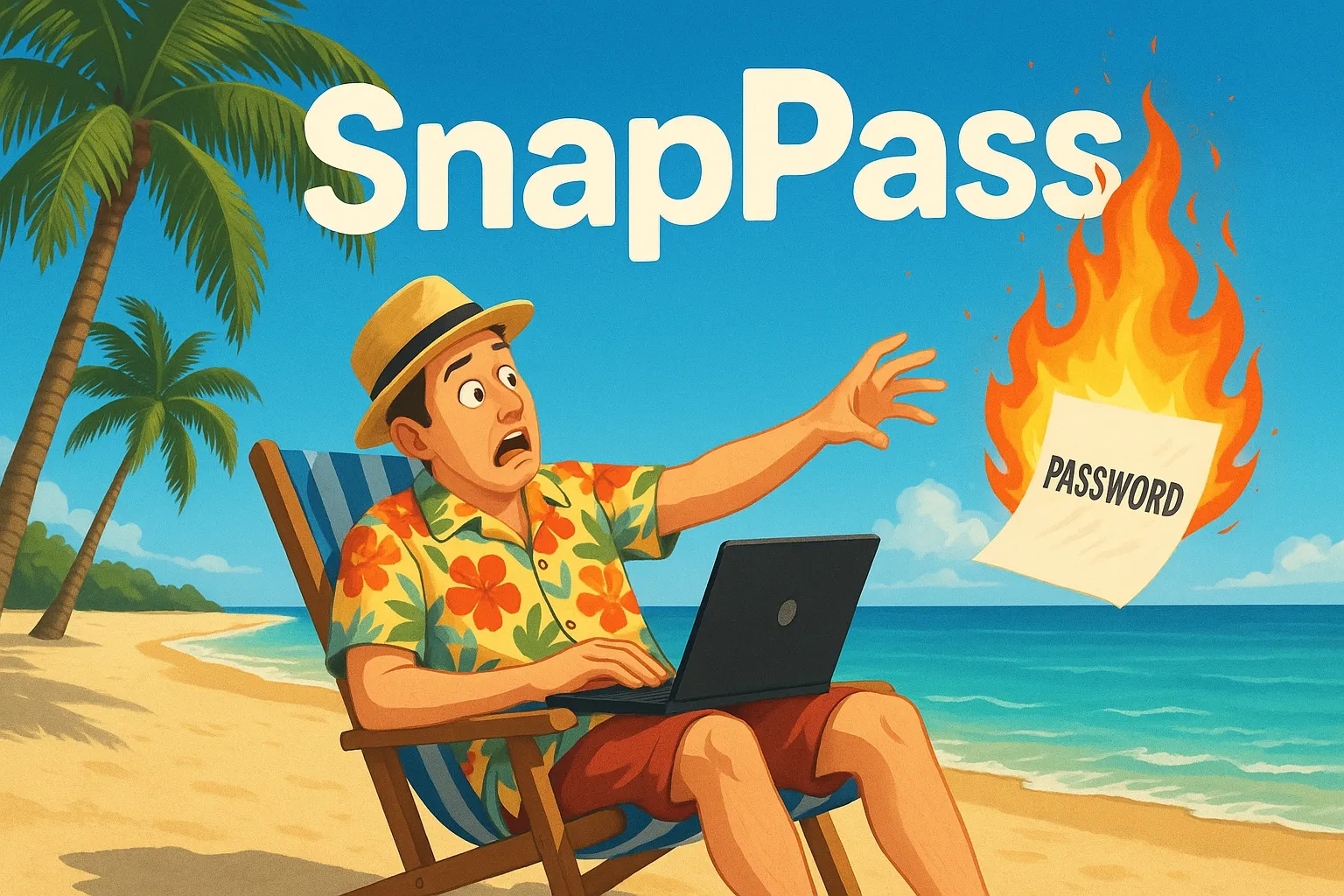

✉️ Subscribe to our newsletter
Receive our latest articles, tips, and promotions directly in your inbox.
We respect your privacy and will never share your data.
Yeah, some links might make me money. Deal with it.
SnapPass: The Secure Password Sharing Tool I Built Because Email Sucks
Holy shit, Day 1 is in the books, and I've already shipped something that actually works. SnapPass is my first micro-startup in this insane 100 Startup Challenge—a secure password sharing tool that makes those sketchy "let me email you the admin password" moments a thing of the past. If you've ever cringed watching someone send credentials through Slack, this one's for you.
Day 1 Down, 99 To Go 🙂🔫 : Why I Built a Password Sharing Tool First
When I decided to build 100 startups in 100 days (yes, I might be having a mild crisis), I knew I wanted to start with something actually useful—not just another todo app the world doesn't need.
So I built SnapPass because this problem drives me fucking crazy: we constantly share sensitive information through channels that are about as secure as shouting passwords across a crowded café. I've watched dev teams, clients, and even security professionals (the irony) send credentials through email, Slack, and text messages, where they'll live forever.
Secure password sharing shouldn't be this hard, and I figured I could solve it in a day. Was I right? Mostly. Did I stay up until 3 AM debugging an encryption issue? Also yes. No one said this challenge would be easy.
What the Hell is SnapPass (And Why Should Anyone Care)?
SnapPass is exactly what it sounds like: a way to share passwords and sensitive shit without leaving digital breadcrumbs everywhere. It creates encrypted, self-destructing messages that vanish after one view (or after a time limit you set).
How SnapPass Works (Without the Technical Bullshit)
- You create a message containing a password, access code, or any sensitive info
- SnapPass generates a secure, encrypted link
- You share that link however you want (email, chat, carrier pigeon)
- The recipient clicks the link to view the secret message
- Once viewed, the message automatically vanishes forever
- No accounts, no email collection, no bullshit
Instead of texting "The Netflix password is FluffyUnicorn99!" to your buddy (which now lives forever on both your phones), you send a SnapPass link that shows the password once, then nukes itself into digital oblivion.
What Makes This Different from Just Texting a Password
The key difference is impermanence. Regular messages are forever—SnapPass messages self-destruct. It's like Mission Impossible but for your Wi-Fi password.
The 5 Security Nightmares SnapPass Actually Solves
Let's be real—we're all sharing passwords we probably shouldn't be sharing. I created SnapPass because:
Problem #1: Email is Where Secrets Go to Die
Every password you've ever emailed still exists on servers somewhere. Forever. That admin password from three jobs ago? Still searchable in your Gmail. That temporary access code you sent a contractor? Immortalized in digital amber. That's terrifying when you think about it.
Problem #2: Slack and Teams are Searchable Time Capsules
That credential from 2019? Still there when someone searches "admin password." I once watched a new employee find database credentials by simply searching "database password" in their team's Slack. They weren't even trying to hack anything—it was just that easy to find.
Problem #3: Data Breaches Expose EVERYTHING
When hackers get into accounts (and they will), they don't just get current messages—they get the entire searchable history of dumb security decisions. Last year, I watched a client accidentally paste their production database credentials into a public Slack channel with contractors. It was like watching a car crash in slow motion—especially when I realized those credentials were still valid.
Problem #4: Remote Work Made This Worse
Now we're all sharing credentials across time zones without proper systems. With distributed teams becoming the norm, the volume of shared passwords has exploded, but our security practices haven't kept up.
Problem #5: People Choose Convenience Over Security
Let's face it, we'll pick the easy insecure way over the complex secure way almost every time. SnapPass makes the secure way the easy way. It's easier to share a SnapPass link than to set up a proper credential manager for a one-time share.
How I Built SnapPass in Less Than 24 Hours
Since this challenge is about building in public, let me pull back the curtain on how Day 1 actually went.
Tech Stack and Decisions
I built SnapPass using:
- Frontend/Backend: Nuxt.js (because duh, it's what I know best)
- Encryption: AES-256 client-side encryption
- Storage: Ephemeral storage that auto-purges
The biggest decision was avoiding a database entirely. No database means no passwords stored anywhere that could be compromised. Instead, encrypted data lives in temporary storage that automatically purges based on timers.
Development Challenges
This wasn't all sunshine and rainbows. The biggest challenges were:
- Client-side encryption that actually works across different browsers (F* you, Chromium)
- Making sure messages truly delete after viewing (harder than it sounds)
- Balancing security with usability (I rebuilt the UI three times)
What I'd Do Differently Next Time
If I had more than a day:
- Add proper end-to-end testing (right now it's... limited)
- Implement better mobile responsiveness (it works but it's not pretty)
- Add browser extensions for one-click sharing (+++)
How the Hell Do You Monetize Something That's Free?
Let's talk money because I'm not building 100 startups for my health. The base SnapPass will stay free (because adoption matters most), but here's my actual monetization game plan:
- Affiliate partnerships with password managers like 1Password and security tools—because if you're using SnapPass, you probably need those too.
- Premium features for businesses who want team accounts, audit logs, or longer expiration windows. Thinking €5/month for teams that need more control?
- White-label options for companies who want to run this under their own brand.
Will this make me rich? Probably not. But the goal of these micro-startups isn't to build unicorns—it's to build useful tools that generate at least some revenue while I sleep. And security tools have surprisingly good conversion rates from free to paid.
Based on similar tools in this space, a realistic target is converting 2% of users to paid plans at €5/month. That means I need about 500 active users to hit a modest €500/month from this single micro-startup.
How Does SnapPass Compare to Alternatives?
| Feature | SnapPass | Slack/Teams | Password Managers | |
|---|---|---|---|---|
| Self-Destructs After Viewing | ✅ | ❌ | ❌ | ❌ |
| No Accounts Required | ✅ | ❌ | ❌ | ❌ |
| End-to-End Encryption | ✅ | Sometimes | Sometimes | ✅ |
| Free to Use | ✅ | ✅ | ✅ | Usually ❌ |
| No Permanent Storage | ✅ | ❌ | ❌ | ❌ |
What's Next: Day 2 Preview and SnapPass Roadmap
SnapPass is live now at snap.100startupchallenge.com if you want to check it out. I'd love your feedback—especially bugs, because I definitely didn't have time to test everything.
For SnapPass itself, I'm planning to add:
- Browser extensions for one-click secure sharing
- API access for developers
- Slack/Teams integrations to make secure sharing even easier
As for tomorrow's startup? I'm thinking something completely different. But that's tomorrow's challenge.
Want to follow along with this insane journey? Subscribe to my newsletter or follow me on BlueSky where I'm documenting each day's progress, failures, and occasional victories.
Now if you'll excuse me, I need to start thinking about Day 2 because this clock doesn't stop ticking.
Skip The Bullshit, Build Faster
No growth hacks. No motivational quotes. Just practical tools to ship products before you overthink them into oblivion.